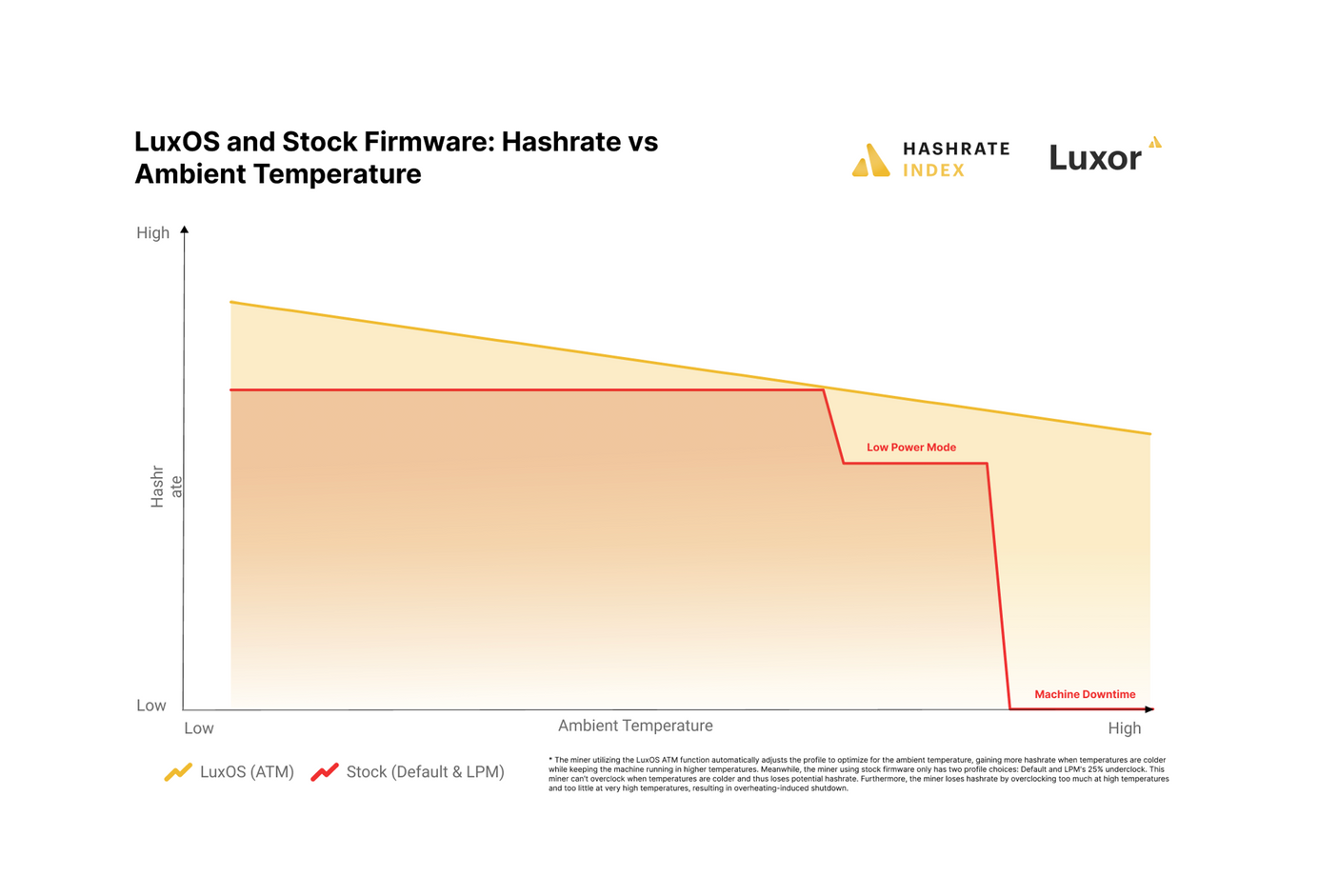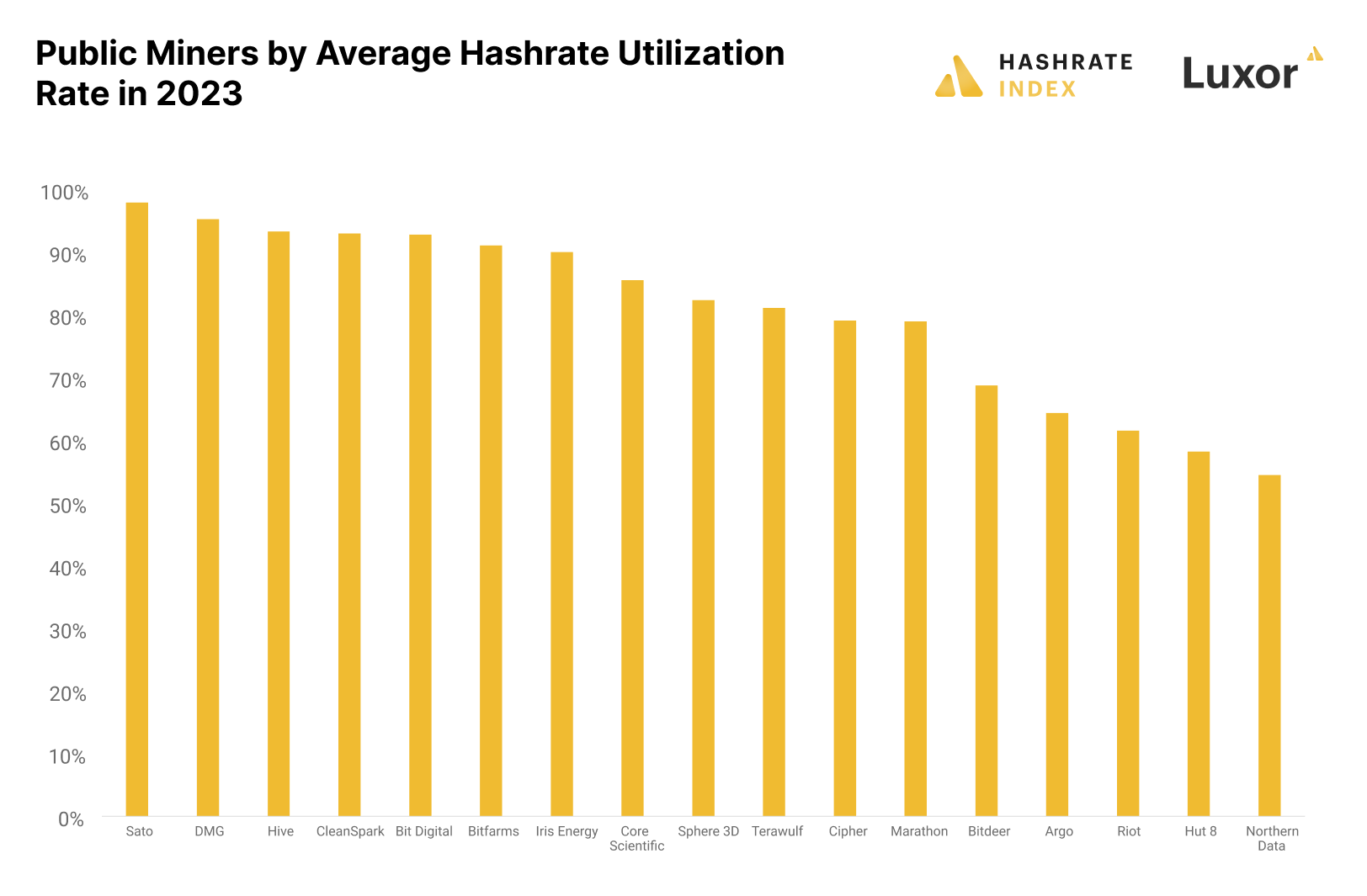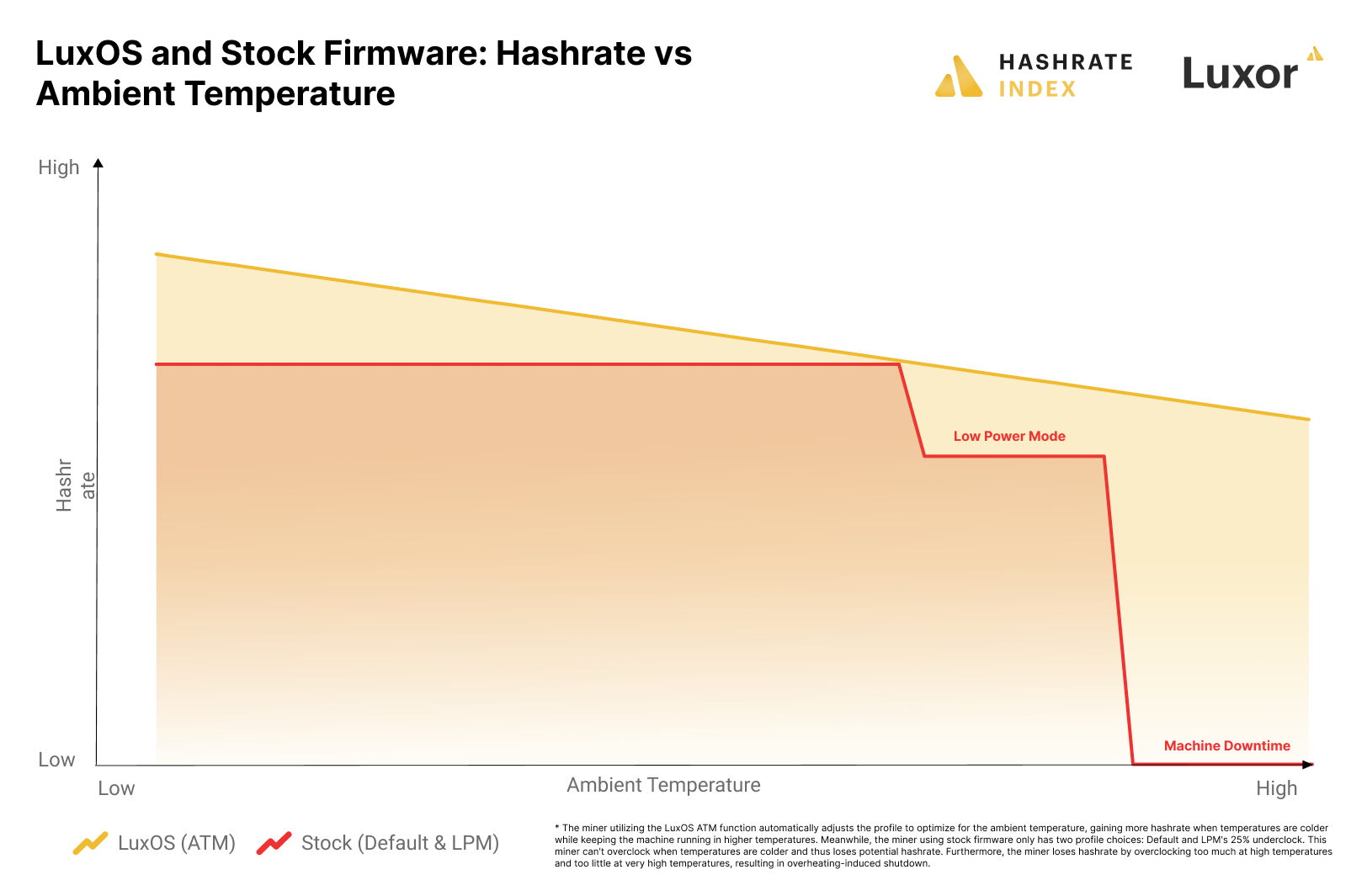
Maximizing hashrate utilization rate with the Luxor firmware
This article explains how bitcoin miners can maximize hashrate utilization rate and revenue by utilizing LuxOS’ Advanced Thermal Management function.
What is the Hashrate utilization rate, and why is it important?
The hashrate utilization rate measures how efficiently a miner transforms its nameplate hashrate into actual bitcoin production. We arrive at this metric by dividing the miner’s bitcoin production by its expected bitcoin production, given its nameplate hashrate.
Let’s run through an example. In August, a miner’s nameplate hashrate of 100 PH/s yielded 6.57 bitcoin. However, given the monthly average bitcoin-denominated hashprice of 0.00241, the miner’s expected production over the 31 days of August was 7.47 bitcoin. We divide 6.57 by 7.47 and find that the miner only realized 88% of its hashrate in August.
Why is the hashrate utilization rate important? A bitcoin miner’s job is to invest in ASICs and maximize the utilization and revenue of these short-lived assets to yield an acceptable return on investment. The higher a miner’s hashrate utilization rate, the higher his revenue and return on investment.

As you can see on the chart above, the payback period of an ASIC investment differs tremendously based on the hashrate utilization rate. The payback period is only 18 months at a 100% hashrate utilization rate while increasing to 31 months at a 60% hashrate utilization rate. Miners should aim for ASIC payback periods of less than 18 months, given the short-lived nature of these assets.
Aside from accessing low-cost electricity, maximizing the hashrate utilization rate is the most critical factor for achieving a high return on investment in ASICs.
The chart below reveals that a handful of public miners’ hashrate utilization rates in 2023 are below 70%, while others score above 90%. As proved in the chart above, the miners with the highest hashrate utilization rates will pay back the ASICs the fastest and achieve the highest return on invested capital, all else equal.

Why are some miners achieving so high hashrate utilization rates compared to others? Several factors come into play - the most important being curtailment. Two types of curtailment exist: economic curtailment and machine downtime. Economic curtailment is the most common and happens when miners voluntarily curtail their machines due to financial incentives such as rising spot electricity prices or demand response obligations. A recent example of economic curtailment was when Riot earned $32 million by shutting down operations in August.
Machine downtime is when miners involuntarily curtail due to non-financial reasons. This is often caused by ambient temperatures exceeding the temperature tolerance of the data center or if there is insufficient airflow. While economic curtailment is often desirable, machine downtime is something miners strive to avoid.
There are several ways to minimize machine downtime, including locating the mine in a cold geographical location, designing the data center to withstand high temperatures, or adjusting the ASICs’ operating parameters using custom firmware. The latter may offer an alternative solution where colder climates and massive construction aren’t an option, as it is cheaper, simpler, and faster to implement than moving or redesigning the entire data center.
How LuxOS’ Advanced Thermal Management maximizes the hashrate utilization rate
LuxOS Firmware has several built-in functions that allow miners to better control and optimize their fleets, including Advanced Thermal Management (ATM). This function automatically manipulates miner clock speed based on board temperatures.
ATM is designed to adjust a miner’s frequency and voltage (and subsequently the heat generated) based on board temperature and user-defined settings and boundaries. As high-heat environments drive hashboard temperatures up, ATM initiates an underclock to prevent miners from reaching dangerous temperatures and shutting down. Entering into the evening, as heat dissipates and machine temperatures drop, ATM will drive the miners back to stock settings or into overclock if user-configured. ATM does not require any integrations, triggers, or human intervention to operate.
Comparatively, a miner using Bitmain’s stock firmware only has two profile choices: default or low-power mode (LPM). Such a miner would run its machines at default mode most of the time while switching to LPM’s 25% underclock in hot environments. The weakness of this methodology is that by only being able to switch between two fixed profiles, the machines will, in most cases, either run at too low or too high of a profile given the temperature constraint.
Thus, the miner will leave hashrate on the table during cold temperatures while also being exposed to the risk of machine shutdowns in the heat, resulting in a lower hashrate utilization rate and return on investment. Also, triggering the switch to low-power mode at the right time requires third-party management software. Triggering too early forfeits extra hashrate and triggering too late risks overheating the machines.
Meanwhile, by dynamically adjusting the machine’s profile to optimize for the current ambient temperature, LuxOS’ ATM function prevents overheating-induced shutdown and helps miners squeeze out their maximum hashrate potential, given the temperature constraint.

The chart above illustrates the complete hashrate profile of two machines: one utilizing LuxOS’ ATM and one using stock firmware. As you can see, ATM automatically adjusts the clock speed according to the board temperature and increases the miner’s hashrate utilization rate by overclocking at lower temperatures.
Meanwhile, the stock firmware will produce approximately the same amount of hashrate at all temperatures up to a certain level, where the miner must manually activate the LPM’s 25% underclock to keep the machine running.
We see that by only having one underclocking profile choice, the miner underclocks too much and forfeits a considerable amount of hashrate. Furthermore, the machine overheats and shuts down at very high temperatures as LPM gives an insufficient underclock. The lost hashrate results in a lower hashrate utilization rate, higher payback period, and reduced return on investment.
On the other hand, LuxOS’ ATM function will automatically underclock at precisely the needed level to keep the machine running, leading to continuous hashrate production in very hot environments and, thus, a higher hashrate utilization rate.
Mining is like Formula 1 - Why keep the same speed during the entire race?
As discussed in the article, continuously running the machine at the same profile is inefficient, no matter the temperature. Imagine two cars competing in a Formula 1 race. The first car holds the same speed during the entire race. In contrast, the second car dynamically adjusts its speed according to the conditions of the track, accelerating during the straightaways and slowing down before the turns. Who do you think would win this race?
Most miners today are now doing the equivalent of holding the same speed during the entire Formula 1 race. These players will either drive off the track in the turns by going too fast or be outpaced by competitors on the straightaways by going too slow. In any case, they will not win the race.
The future winners of the bitcoin mining race will be those who can adapt the best to varying conditions and use their resources most effectively. Automatically adjusting the clock speed according to varying board temperatures, the Advanced Thermal Management function of LuxOS helps miners stay ahead of competitors by letting them squeeze out extra hashrate in cold environments and preventing overheating-induced operational curtailment in hot environments. This ultimately leads to increased hashrate utilization rate and return on invested capital.
Increase your hashrate utilization rate today with the Luxor Firmware.
Hashrate Index Newsletter
Join the newsletter to receive the latest updates in your inbox.








